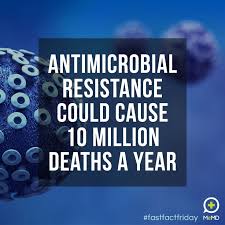21
Nov
Herbicide Caused Antibiotic Resistance Not Regulated
(Beyond Pesticides, November 21, 2017) Both the active and inert ingredients in common herbicides induce antibiotic resistance in human pathogenic bacteria,  according to the latest research from New Zealand scientists, published in Microbiology this week. Previous research from the same team found in 2015 that commercial formulations of Roundup (containing glyphosate and inert ingredients) and Kamba (containing 2,4-D, Dicamba, and inert ingredients) caused antibiotic resistance to develop in Salmonella eterica and Escherichia coli, but this new research drills down into what ingredients in these formulations resulted in the effect. Lead author of the study, Jack Heinemann, PhD, University Canterbury’s School of Biological Sciences, explains that ultimately this research indicates that, “The sub-lethal effects of industrially manufactured chemical products should be considered by regulators when deciding whether the products are safe for their intended use,”
according to the latest research from New Zealand scientists, published in Microbiology this week. Previous research from the same team found in 2015 that commercial formulations of Roundup (containing glyphosate and inert ingredients) and Kamba (containing 2,4-D, Dicamba, and inert ingredients) caused antibiotic resistance to develop in Salmonella eterica and Escherichia coli, but this new research drills down into what ingredients in these formulations resulted in the effect. Lead author of the study, Jack Heinemann, PhD, University Canterbury’s School of Biological Sciences, explains that ultimately this research indicates that, “The sub-lethal effects of industrially manufactured chemical products should be considered by regulators when deciding whether the products are safe for their intended use,”
Scientists parsed out the effects of individual active and inert ingredients by obtaining pure, technical grade dicamba, 2,4-D, and glyphosate, as well as the inert co-formulants “Tween80” and “CMC,” which are respectively, used to reduce surface tension and regulate the viscosity in a formulated herbicide, though also used as emulsifiers in foods like ice cream and in medicines. The technical grade herbicides were first applied to S. eterica, and then a range of antibiotics including ampicillin (Amp), chloramphenicol (Cam), ciprofloxacin (Cip), kanamycin (Kan) and tetracycline (Tet) were used to treat the bacteria. Inert ingredients were applied to both S.eterica and E. coli and then the same antibiotics were tested. Researchers measured the ability for the bacteria to live in a petri dish when compared to unexposed bacteria, a term called efficiency of plating.
Results show a range of effects, with the herbicides conferring different levels of resistance based on the antibiotic used. 2,4-D, for instance, decreased antibiotic resistance in Salmonella eterica after Cam exposure, but increased it after Kan exposure. The inert ingredients recorded similar outcomes, although on the whole their effect was weaker than the active ingredients. In general, the effects of the active ingredients on antibiotic resistance were similar to results found in the original research with formulated products. However, with this study, very small, and much larger amounts of active ingredient were used, indicating that antibiotic resistance is conferred even below levels reasonably expected to be seen in the environment.
Dr. Heinemann notes, “These products are sold in the local hardware store and may be used without training, and there are no controls that prevent children and pets from being exposed in home gardens or parks. Despite their ubiquitous use… herbicides may be undermining the use of a fundamental medicine-antibiotics.”
Current pesticide registration protocols under the U.S. Environmental Protection Agency require testing on only the active ingredient in a pesticide formulation. Tests also are limited in the health and environmental impacts investigated, and generally only look at acute and chronic pesticide exposure, and subsequent morality as an endpoint. Dr. Heinemann explains that, “Where this information is sought, it is usually only for people or animals. We are unaware of any regulator ever considering the risk of sub-lethal effects on bacteria. That is what makes this new research so important.” Given that inert ingredients conferred differing levels of antibiotic resistance than active and formulated products, it is evident there are complex, and significant mechanisms that are not being investigated by U.S. pesticide regulators.
The stakes are very high. “The United States, for example, estimates that more than two million people are sickened every year with antibiotic-resistant infections, with at least 23,000 dying as a result. By 2050, resistance is estimated to add 10 million annual deaths globally with a cumulative cost to the world economy of US$100 trillion,” Dr. Heinemann says.
Modern science is just beginning to understand the broad range of effects caused by microbes in our body and our environment. In addition to antibiotic resistance, glyphosate has been linked to alteration of gut microbial diversity, as well as the diversity of soil organisms. Exposure to organophosphate insecticides has been linked to changes in the diversity of bacteria in one’s mouth. The G20 earlier this year called on nations to address the rise of antibiotic resistance.
As Dr. Heinemann notes, “More emphasis needs to be placed on antibiotic stewardship compared to new antibiotic discovery. Otherwise, new drugs will fail rapidly and be lost to humanity.” It is evident that more needs to be done from regulators throughout the world to make certain that chemicals permitted into the environment where they make their way into soil, water, and air at minute levels, are not undermining our health in ways beyond those already known.
For more information on the impact of pesticides on the microbes in our bodies and our health, see Beyond Pesticides cover story in the summer 2017 issue of Pesticides and You, and go to our YouTube page to watch the keynote talk from David Montgomery, PhD, at Beyond Pesticides National Pesticide Forum, on his book The Hidden Half of Nature: The Microbial Roots of Life and Health.
All unattributed positions and opinions in this piece are those of Beyond Pesticides.
Source: University of Canterbury Press Release










